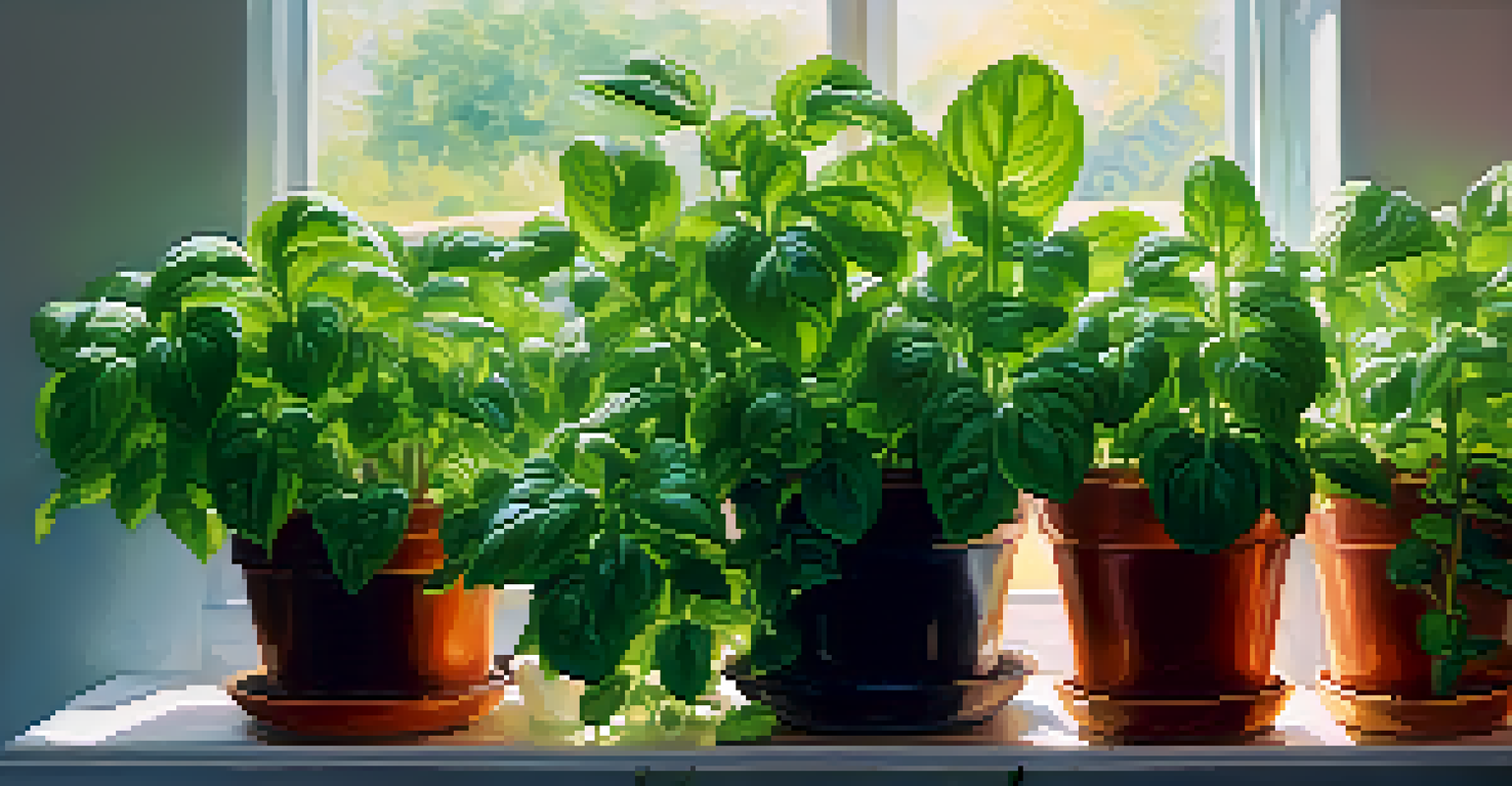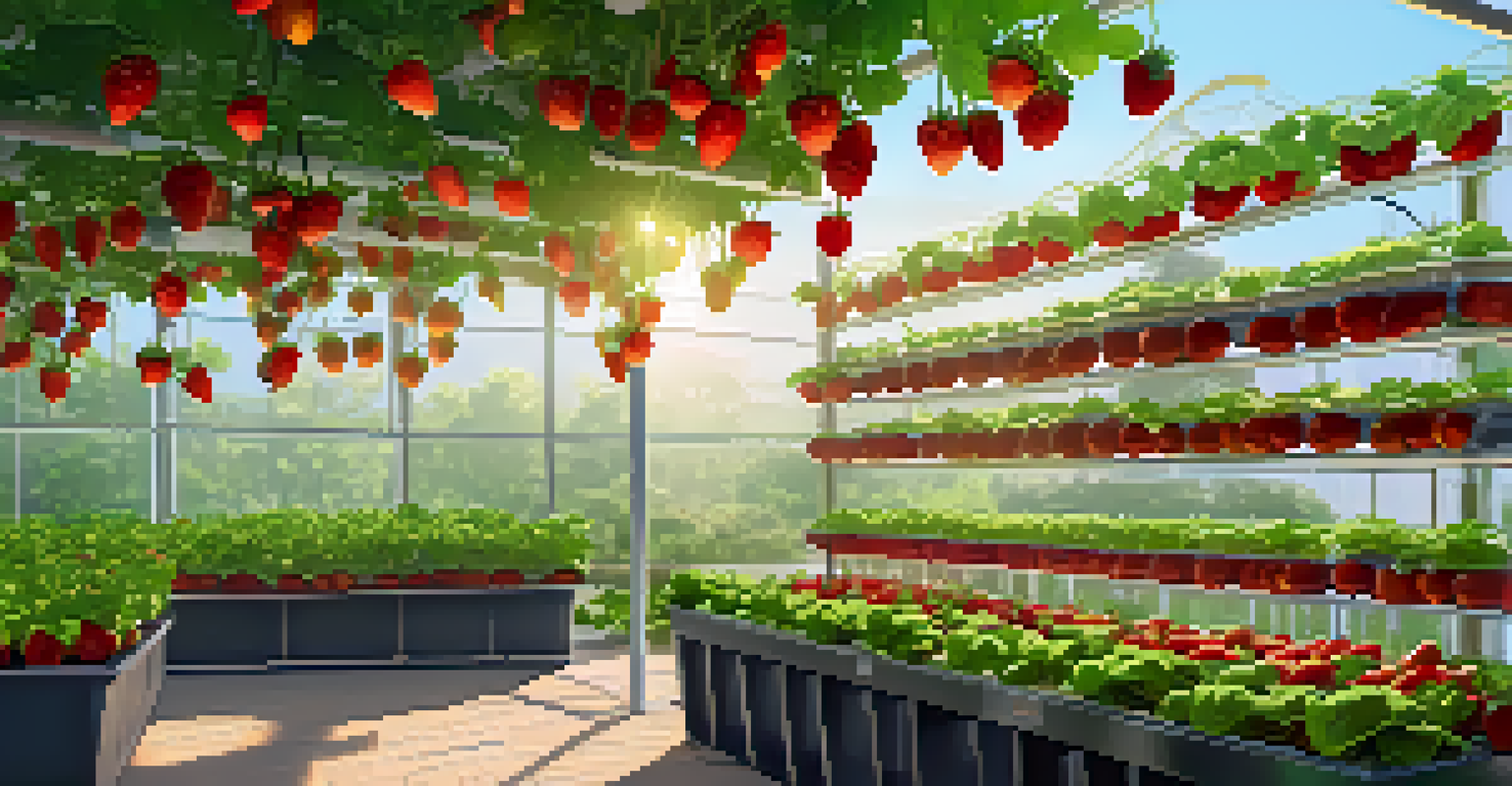How to Set Up Your First Hydroponic Garden at Home

Understanding Hydroponics: The Basics Explained Simply
Hydroponics is a method of growing plants without soil, using nutrient-rich water instead. This innovative approach allows plants to absorb essential nutrients directly from the solution, promoting faster growth and higher yields. Imagine it as giving your plants a nutritious drink, rather than waiting for them to extract what they need from the soil.
The greatest gift of the garden is the restoration of the five senses.
One of the most appealing aspects of hydroponics is that you can grow fresh produce indoors or outdoors, regardless of the season. This means you can enjoy fresh herbs and vegetables right from your home, even in winter! Plus, it uses less water than traditional gardening, making it an eco-friendly choice.
Before diving into setting up your garden, it's essential to familiarize yourself with different hydroponic systems, like nutrient film technique (NFT) or deep water culture (DWC). Each system has its unique benefits, so understanding them will help you choose the best fit for your space and goals.
Choosing the Right Location for Your Hydroponic Garden
Selecting the perfect spot for your hydroponic garden is crucial for its success. Look for a location that receives plenty of natural light, such as near a south-facing window or a well-lit room. If natural light is limited, consider investing in grow lights to ensure your plants get the energy they need to thrive.

Additionally, the temperature and humidity of the location play a significant role in plant growth. Most plants prefer a temperature range of 65-75°F (18-24°C) and humidity levels between 40-60%. Make sure the area you choose can maintain these conditions, or be ready to make adjustments with equipment like fans or humidifiers.
Hydroponics: Soil-Free Growth
Hydroponics allows plants to grow in nutrient-rich water instead of soil, leading to faster growth and higher yields.
Lastly, ensure that the space is easily accessible for maintenance tasks like watering and harvesting. A clutter-free environment will make it easier for you to monitor your plants and make any necessary adjustments. The more comfortable you are in this space, the more enjoyable your gardening experience will be!
Essential Equipment and Supplies: What You Need to Start
To set up your hydroponic garden, you'll need some essential equipment and supplies. Key items include a hydroponic system (like a grow box or vertical garden), grow lights if necessary, a water pump, and nutrient solutions. Think of this equipment as the building blocks of your garden, providing everything your plants need to flourish.
Gardening adds years to your life and life to your years.
Don't forget about growing mediums! While hydroponics doesn't use soil, materials like coconut coir, perlite, or clay pellets provide support for your plants. These mediums help anchor the roots while allowing for proper drainage and aeration, which are crucial for healthy growth.
Finally, investing in pH testing kits and an electrical conductivity (EC) meter can greatly enhance your hydroponic gardening experience. These tools help you monitor and adjust the nutrient solution to ensure your plants are receiving the right balance of nutrients, making it easier to achieve optimal growth.
Choosing Plants for Your First Hydroponic Garden
When selecting plants for your hydroponic garden, it's best to start with easy-to-grow varieties. Leafy greens like lettuce, spinach, and kale are excellent choices for beginners, as they grow quickly and adapt well to hydroponic systems. Think of them as the perfect starter recipes that build your confidence as you learn!
Herbs like basil, cilantro, and mint also thrive in hydroponic systems and can add fresh flavors to your meals. Plus, these plants are typically small, making them suitable for limited space. Imagine snipping fresh basil for your pasta right from your kitchen—what a delightful experience!
Choose the Right Location
Selecting a well-lit, temperature-controlled space is essential for the success of your hydroponic garden.
As you gain experience, you can experiment with other plants like strawberries or tomatoes. Just remember that each plant has specific light and nutrient needs, so it's essential to research their requirements before diving in. This knowledge will help you create a diverse and thriving hydroponic garden.
Setting Up Your Hydroponic System: Step-by-Step Guide
Setting up your hydroponic system may seem daunting, but breaking it down into simple steps makes it manageable. Start by assembling your chosen hydroponic system according to the manufacturer's instructions. Think of it as putting together a puzzle—just follow the pieces, and you'll have a functioning system in no time!
Next, fill your system with the appropriate growing medium and plant your seeds or seedlings. Make sure to follow the recommended spacing guidelines for each plant type, allowing them room to grow. After planting, carefully monitor the water levels and nutrient solution, ensuring everything is balanced for optimal growth.
Finally, set up your grow lights if you're growing indoors, and adjust their height as your plants mature. Regularly check on your plants to ensure they’re healthy and thriving. Over time, you'll become more comfortable with the process, making adjustments as needed to keep your garden flourishing.
Maintaining Your Hydroponic Garden: Tips for Success
Maintaining your hydroponic garden is key to achieving healthy plants and a bountiful harvest. Regularly check the water levels and nutrient solution, topping off as needed. Think of it as checking in on a friend—you want to ensure they're getting everything they need to thrive!
Monitoring the pH and EC levels of your nutrient solution is also essential. Aim for a pH between 5.5 and 6.5, as this range is ideal for most hydroponic plants. If you notice any imbalances, make adjustments promptly to keep your plants happy and healthy.
Essential Equipment for Success
Key supplies like a hydroponic system, grow lights, and nutrient solutions are vital for establishing a thriving garden.
Additionally, keep an eye out for pests and diseases. While hydroponic systems are less prone to certain issues, it’s still vital to monitor your plants regularly. If you spot any problems, take action quickly—whether that's isolating affected plants or adjusting your growing conditions.
Harvesting Your First Crops: The Reward of Your Efforts
After weeks of care and attention, it’s finally time to enjoy the fruits of your labor! Harvesting your crops can be incredibly rewarding, especially when you see how much you've accomplished. Start with leafy greens by cutting the outer leaves while leaving the inner ones to continue growing. It's a great way to encourage further growth!
For herbs, simply snip off what you need, allowing the plant to keep producing. The beauty of hydroponic gardening is that you can enjoy continuous harvests, giving you a supply of fresh ingredients for your meals. Imagine the satisfaction of cooking with ingredients you've grown yourself!

Once you've harvested, take a moment to reflect on what you've learned throughout the process. Each season will bring new challenges and surprises, making your gardening journey an ever-evolving adventure. Embrace the experience, and don't hesitate to share your successes with friends and family!